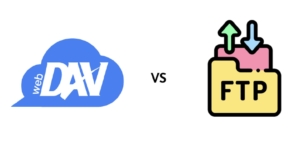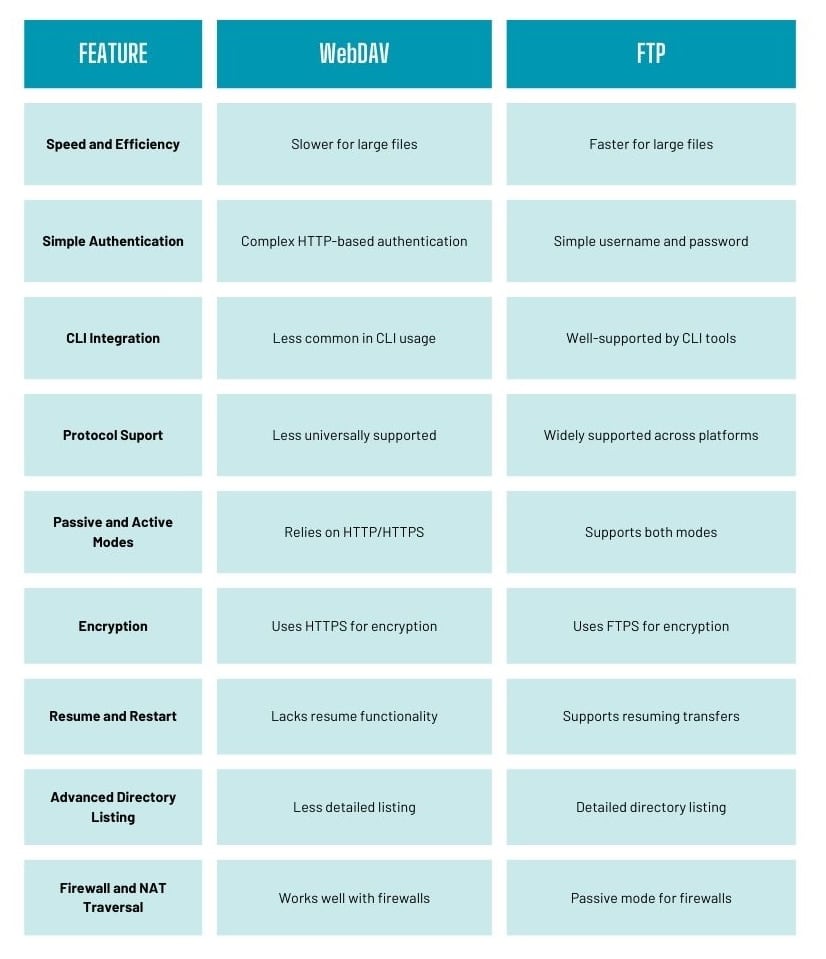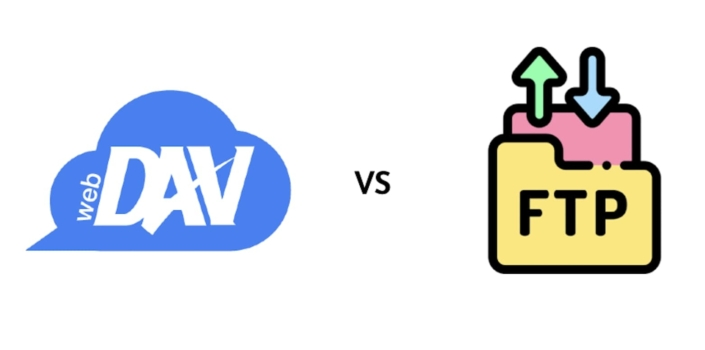
WebDAV and FTP are file transfer protocols that serve distinct purposes and functionalities
and cater to different needs.
Understanding their characteristics, applications, and differences is crucial for determining
which protocol best suits specific requirements.
What is WebDAV?
Web-based Distributed Authoring and Versioning (WebDAV) extends
the capabilities of the HTTP protocol, enabling collaborative file management directly on web
servers. This protocol enhances the functionality of HTTP, which traditionally serves static content, by
allowing users to edit, update, and manage files remotely.
Features of WebDAV:
WebDAV introduces several advanced features essential for collaborative work environments:
- File Locking: One of its standout features, WebDAV supports automatic
file locking to prevent simultaneous modifications by multiple users, ensuring data integrity and
minimizing conflicts.
- Metadata Support: XML properties enable comprehensive management of file
metadata, including author information, modification dates, and namespace manipulation for efficient
resource organization and retrieval.
What is FTP?
File Transfer Protocol (FTP) remains a foundational
protocol for transferring files between computers over networks. It
operates on a client-server architecture, where an FTP client initiates a connection to an FTP server to
perform file operations such as uploading, downloading, and managing directories.
Types of FTP:
FTP exists in multiple variants, each offering specific features and levels of security:
- FTP: The original protocol, established in the early 1970s, operates
over TCP port 21. It transfers data in plain text, which can be a security concern when sensitive
information is involved.
- FTPS: Also known as FTP Secure or FTP-SSL, FTPS adds support for
Transport Layer Security (TLS) or Secure Sockets Layer (SSL) encryption. It secures data
transmission over TCP ports 21 or 990, enhancing security during file transfers.
- SFTP: Despite its name, SFTP stands for SSH File Transfer Protocol and
differs significantly from FTP. It runs over an SSH (Secure Shell) connection on TCP port 22,
providing encrypted file transfer and remote file system management capabilities.
WebDAV vs FTP: Key Differences
- Security: WebDAV, FTPS, and SFTP offer varying levels of security.
WebDAV itself does not provide built-in encryption but can be secured by running over HTTPS. FTP
lacks encryption by default, making data vulnerable to interception during transmission unless using
FTPS or SFTP.
- File Locking: WebDAV supports automatic file locking, preventing
conflicts when multiple users access and modify the same file simultaneously. In contrast, FTP lacks
native file locking mechanisms, which can lead to overwriting issues in collaborative environments.
- Protocol Usage: WebDAV finds extensive use in collaborative platforms,
content management systems (CMS), and document sharing environments where real-time editing and
metadata management are critical. FTP, on the other hand, is preferred for simple file transfers,
bulk data movement, and accessing public FTP archives.

WebDAV vs FTP: Choosing
the Right
Protocol
- WebDAV: Suitable for scenarios requiring collaborative
editing, version
control, and extensive metadata management. Examples include collaborative document
editing
platforms, where multiple users need simultaneous access to files without risking
data loss or
conflicts.
- FTP: Ideal for straightforward file transfers where
encryption and
advanced features like file locking are less critical. It remains a popular choice
for bulk data
movement, website content updates via FTP clients, and accessing publicly available
files on FTP
servers.
WebDAV vs FTP: Real-World
Applications
- WebDAV Use Cases: In enterprise environments, WebDAV
facilitates
efficient content management and collaborative document editing. Platforms like Microsoft
SharePoint can leverage WebDAV for seamless integration with desktop applications,
enabling users to
edit documents directly on the server without the need for local downloads.
- FTP Use Cases: Public FTP archives serve as repositories
for software
updates, multimedia files, and large datasets accessible to users worldwide. FTP
clients like FileZilla provide
intuitive interfaces for uploading website files, managing directories, and ensuring
seamless file
transfer operations.
Conclusion
Knowing the differences between WebDAV and FTP helps people and businesses
pick the best way
to access files,
stay secure, and work together. Whether you want to help your team work better by
editing documents at
the same time or safely move important data, choosing the right method makes everything
run smoothly and
keeps data safe.
FAQ
What are the main differences between WebDAV
and FTP?
The primary differences lie in their functionalities and
intended use cases. WebDAV extends the HTTP protocol to enable collaborative file
management
and versioning directly on web servers. It supports features like automatic file locking
and
comprehensive metadata management. FTP, on the other hand, is a basic protocol for
transferring files between computers. It lacks native support for file locking and
advanced
metadata handling but offers variants like FTPS and SFTP for enhanced security.
Which protocol is more secure: WebDAV or FTP?
In terms of security, FTP lacks encryption by default,
making it
vulnerable to data interception during transmission. However, FTPS (FTP over TLS/SSL)
and
SFTP (SSH File Transfer Protocol) provide encryption options, enhancing security during
data
transfer. WebDAV itself does not include encryption but can run over HTTPS for secure
communication. Therefore, the choice depends on the level of security required for file
transfers and collaborative work.
In what scenarios should I use WebDAV over FTP?
WebDAV is ideal for scenarios requiring real-time
collaborative
editing, version control, and extensive metadata management. It is commonly used in
content
management systems (CMS), document sharing platforms, and collaborative work
environments
where multiple users need simultaneous access to files without the risk of overwrites or
data loss. Examples include editing documents directly on a server using Microsoft
SharePoint or managing content in collaborative online platforms.
Can FTP be used for secure file transfers?
While standard FTP does not provide encryption, FTPS and
SFTP
offer secure options for file transfers. FTPS uses SSL/TLS encryption to secure data
transmission over FTP ports (21 or 990), while SFTP operates within an SSH session on
port
22, providing encrypted file transfer and remote file system management capabilities.
Organizations handling sensitive data often opt for FTPS or SFTP to ensure data
integrity
and confidentiality during file transfers.


